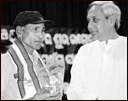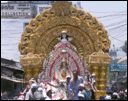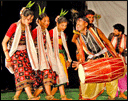Art and Culture of Sambalpur District
Sambalpur serves as the gateway to the bewitching western zone of Odisha . It is the epicenter of a very high profile and rich culture.Its culture and art is an unique proposition of dance, music, handicraft, believes, social values, traditional practices etc.
(Rangabati Rangabati kanaklata hasi pade kahana katha….sang by Jitendra Haripal)
From a much un-privileged and unknown rural area of this District crossed the boundary of the country and put its foot step in the foreign land. Since that day, sambalpuri song has got tremendous demand from various parts of the world. It is this part of Odisha where people believe in simplicity, unity and love to the nature. Here, tribals dance with the beats of Dhole, Madal, Nishan. People enjoy the get together with family members, friends in Nuakhai-Bhet Ghat,so called in Sambalpuri language. Again the District looks very colorful in the time of celebrating Sitalsasthi.
Sambalpur is famous for its handloom textile works which has earned international reputation in recent times.Its main format well known asSambalpuri saree is becoming a must to wear for every Oriya. The textiles for their unique design and texture commonly come under the patent of Sambalpuri handloom.As we all know culture is the conglomerated pattern of language, social values, music, festivals etc.



Language
Agnya juhar. Muin sambalpur nu kahuchein. Eta hauchein maa ista devi samaleswari ra sahar( Hello sir, I am from sambalpur, the place of goddess Samaleswari.). In this way the inhabitants of this land introduce themselves to others. But the Principal language of the District is Oriya. Other Indian languages spoken by the people of Sambalpur District are Hindi, Urdu, Bengali, Telugu, Gujarati, Punjabi and Tamil. Tribal languages like Kisan, Kui, Oraon, Kharia etc. are also popularly spoken by the tribal people of the District. The language spoken in Sambalpur differs from that spoken in the Coastal Districts of Odisha. It is generally known as Sambalpuri and is spoken in Western part of Odisha.
Dance in the District of Sambalpur
This is the land of tribal dance, where tribals dance with the rhythm of beautiful traditional songs. Most of the community dances of the District are connected with a function or the worship of a deity. The Folk-Dances of Sambalpur are so colorful that visitors enjoy it with lot of enthusiasm. A few prominent dances of the District are as follows:
Dalkhai Dance
Young girls of Binjhals, Soura and Mirdha tribes perform this dance during Dussehra, Bhaijuntia and other festive occasions. The young girls stand in a line or in a semicircular pattern with song known as Dalkhai songs.
Karma Dance
Karma is the most colorful dance of the District. It is a tribal dance in honour of “Karam Sain”, the deity who grants children, as they belive. In the beginning the dancers enter the dancing arena in two rows. The drummers and the singers accompany with rhythmic steps.
Humo & Bauli
These are two playful dances performed by young and un-married girls on special occasions that sing and dance in groups. The stepping and movements of the dance are very slow.
Koisabadi Dance
This dance is prevalent among the Gond and the Bhuyan tribes. Male dancers take part, holding a two feet long stick. The songs are mainly based on the immortal love story of Radha and Krishna.
Use of Musical Instruments in Sambalpur
The Folk instruments which are in vogue in Sambalpur Region are Dhole, Madal, Nishan, Tasa, Pakhoj, Bansi, Bir- Kahali, Gini, Ektara, Muhuri, Ghulgula, Ghunguru, Jhanj etc.
Dhole
It is an age old instrument of Indian Folk Music. The Dhole of Sambalpur is slightly different in its making and use. It is made of trunk of a tree. Both the side of the Dhole is of same size. Sambalpur Dhole can be used for any type of Sambalpuri Folk Song.
Madal
The Sambalpuri Madal is different from that of all other parts of India. The Madal is made out of fired clay and is like a cylinder. Madal is a drum which is used in slower rhythms. Most of the non-dance songs are accomplished with the Madal.
Nishan
Nishan is made out of iron sheets. The sound emitted by the Nishan is heart-throbbing. This is mostly used in worship of Kali or Durga and in the battle field.
Tasha
Tasha is played by two thin bamboo sticks. The sound of Tasha creates an atmosphere of horror, fear and excitement.
Festivals
Sital Sasthi
It is the Marriage Ceremony of Lord Shiva with Goddess Parvati. The festival is observed in the month of June with pomp and ceremony at Sambalpur and is extended for a week. Pilgrims from the neighboring Districts and States of Madhya Pradesh and Bihar also participate in the festival. Lakhs of people congregate in this week long festival, mostly in the month of June every year.
Nuakhai
This is the most important social festival of Sambalpur. Generally it takes place during the month of August and September. Preliminary preparation of the festival starts 15 days before the occasion. The first grains of the paddy crop, cooked into various dishes are offered to the deities. There after the eldest member of the family distributes new rice to the junior members of the family. All the household articles are cleaned. People greet each other. It is a community festival celebrated by every Hindu family low and high.
Bhaijiuntia
It is mostly known only in the region of Western Odisha. Bhaijiuntia festival is celebrated on the Mahastami Day of Durga Puja. It is a total fasting undertaken by girls and women for the whole day and night to seek Goddess Durga’s blessing for the long life of their brothers( in Oriya language, it is called bhai).
Puajiuntia
It is another fasting Puja of similar austerity for women of the area. The Puajiuntia festival is observed by mothers to invoke the grace of Lord Dutibahana for the long life and prosperity of their sons. Besides the above listed festivals, other religious festivals are also observed in the District. These include Shiva Ratri, Dola Jatra, Durga Puja, Janmastami, Dipavali, Ganesh Puja and Saraswati Puja. Shiva Ratri Mela at Huma attracts a large number of devotees. Ratha Jatra is held at almost all central places of Sambalpur. On the occasion of Makara Jatra, a fair is held at Themra in Sambalpur. The most popular festivals celebrated by Muslims are Id-Ul-Fitre, Id-Ul-Juha and Muharram. The Sikhs also celebrate the Birth Day of Guru Nanak.
Architecture
The architecture in the District attracts the people of all over the world because of its unique designing. The temple architecture of the District sheds a lively picture of the cultural heritage of the District.
Temples
The important historical relics in the District of Sambalpur are the temples built by the Chauhan rulers. The splendour of Odisha Art and Architecture had reached its climax in 13th century much before the advent of the Chauhans into Sambalpur region.
- The Pataneswari temple of Sambalpur was built by Balaram Dev, the first Chauhan ruler of Sambalpur in the last part of 16th century. It consists of a sanctum with an enclosed circular count. Goddess Kali is worshipped in the temple of pataneswari.
- The image of Samalai is an unique sculpture and appears to be a primitive deity worshipped by the local people.
- The Bimaleswar Shiv temple of Huma popularly called as the leaning temple is found on the river Mahanadi. It was built by Maharaja Baliar Singh. The rest of the temples were constructed during the reign of Ajit Singh and his sons Abhaya Singh. All these temples are of great artistic beauty.








